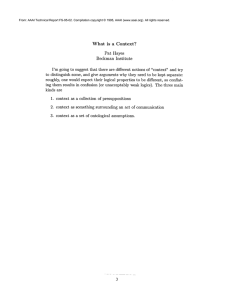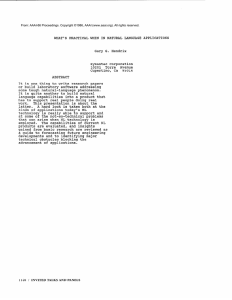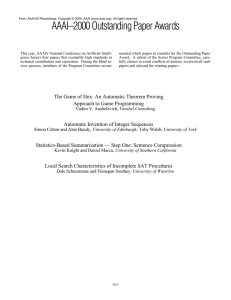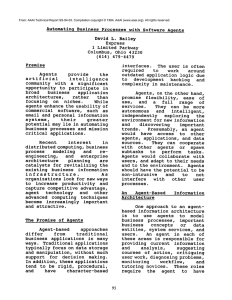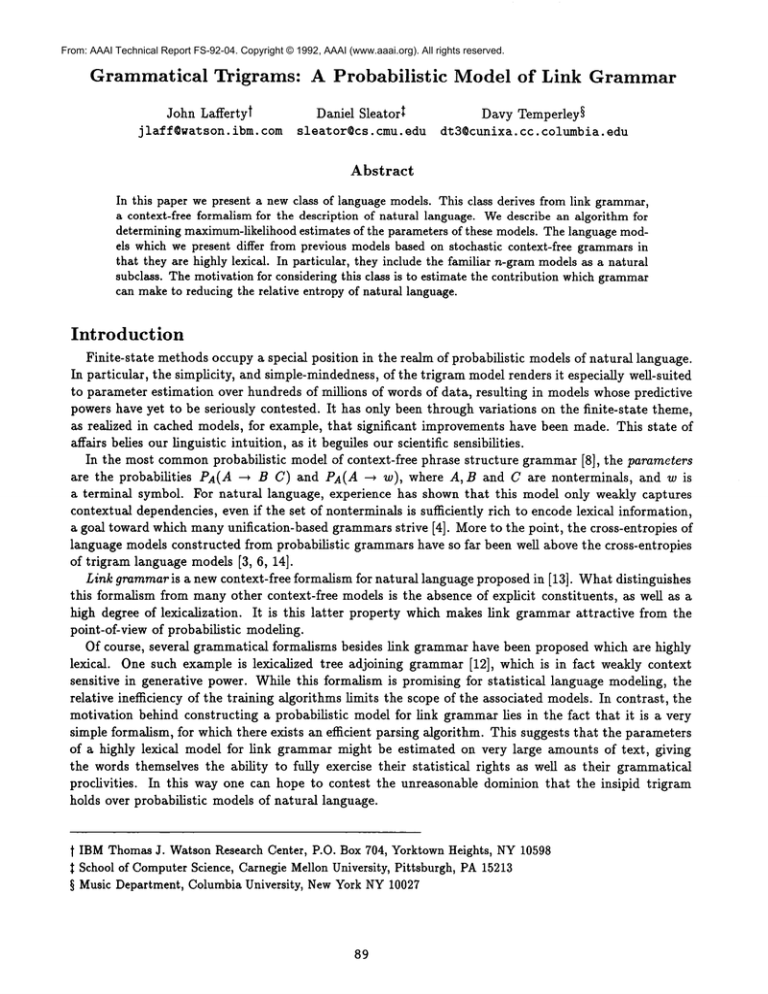
From: AAAI Technical Report FS-92-04. Copyright © 1992, AAAI (www.aaai.org). All rights reserved.
Grammatical
Trigrams:
A Probabilistic
Model of Link Grammar
John Laffertyt
Daniel Sleator~
Davy Temperley§
j 1all@watson. ibm. com sleator@cs, cmu. edu dt3@cun±xa, cc. columb±a, edu
Abstract
In this paper we present a new class of language models. This class derives from link grammar,
a context-free formalismfor the description of natural language. Wedescribe an algorithm for
determining maximum-likelihood
estimates of the parameters of these models. The language models which wepresent differ from previous models based on stochastic context-free grammarsin
that they are highly lexical. In particular, they include the familiar n-grammodelsas a natural
subclass. Themotivation for considering this class is to estimate the contribution whichgrammar
can maketo reducing the relative entropy of natural language.
Introduction
Finite-state methodsoccupy a special position in the realm of probabilistic models of natural language.
In particular, the simplicity, and simple-mindedness,of the trigram modelrenders it especially well-suited
to parameter estimation over hundreds of millions of words of data, resulting in models whose predictive
powers have yet to be seriously contested. It has only been through variations on the fiuite-state theme,
as realized in cached models, for example, that significant improvements have been made. This state of
affairs belies our linguistic intuition, as it beguiles our scientific sensibilities.
In the most commonprobabilistic model of context-free phrase structure grammar[8], the parameters
are the probabilities
PA(A ~ B C) and PA(A ~ w), where A, B and C are nonterminals, and w is
a terminal symbol. For natural language, experience has shown that this model only weakly captures
contextual dependencies, even if the set of nonterminals is sufficiently rich to encode lexical information,
a goal toward which manyunification-based grammarsstrive [4]. Moreto the point, the cross-entropies of
language models constructed from probabilistic grammarshave so far been well above the cross-entropies
of trigram language models [3, 6, 14].
Link grammaris a new context-free formalism for natural language proposed in [13]. Whatdistinguishes
this formalism from manyother context-free models is the absence of explicit constituents, as well as a
high degree of lexicalization.
It is this latter property which makes link grammarattractive from the
point-of-view of probabilistic modeling.
Of course, several grammatical formalisms besides link grammarhave been proposed which are highly
lexical. One such example is lexicalized tree adjoining grammar[12], which is in fact weakly context
sensitive in generative power. While this formalism is promising for statistical language modeling, the
relative inefficiency of the training algorithms limits the scope of the associated models. In contrast, the
motivation behind constructing a probabilistic model for link grammarlies in the fact that it is a very
simple formalism, for which there exists an efficient parsing algorithm. This suggests that the parameters
of a highly lexical model for link grammarmight be estimated on very large amounts of text, giving
the words themselves the ability to fully exercise their statistical rights as well as their grammatical
proclivities.
In this way one can hope to contest the unreasonable dominion that the insipid trigram
holds over probabilistic models of natural language.
t IBMThomasJ. Watson Research Center, P.O. Box 704, YorktownHeights, NY10598
School of ComputerScience, Carnegie MellonUniversity, Pittsburgh, PA15213
§ Music Department, Columbia University, NewYork NY10027
89
From: AAAI Technical Report FS-92-04. Copyright © 1992, AAAI (www.aaai.org). All rights reserved.
Link grammar
The best way to explain the basics of link grammaris to discuss an example of a linkage. Figure 1
shows howa linkage is formed whenthe words, thought of as vertices, are connected by labelled arcs so
that the resulting graph is connected and planar, with all arcs written above the words, and not more
than one arc connecting any two words. The labelled arcs are referred to as links.
Stately, plump Buck Mulligan came from the stairhead ,
bearing a bowl of lather on which a mirror and a razor lay crossed.
FIGURE 1
A usage of a word w is determined by the manner in which the word is linked to the right and to the
left in a sentence. In Figure 1, for example, the word "came" is seen to be preceded by a subject, and
followed by two adverbial phrases, separated by a comma.This usage of "came" is characterized by an S
connector on the left, and two right EVconnectors, separated by a Comma
connector. Wecan thus say that
one usage of the word"came"is ((S), (EV, Comma,
EV)). Similarly, a usage of the word "and" is ((N),
that is, it maycoordinate two noun phrases as the subject of a verb. Of course, the labels in the above
examples are quite simple; to incorporate more structure, it would be natural for the connectors to be
represented by feature structures, and for linking to makeuse of unification.
A dictionary specifies all possible usages of the words in the vocabulary. A usage will also be referred
to as a disjunct, and is represented by a pair of ordered lists
d = ((l,~, l,~-1,...,It),
(rl, r2,...,n)).
The li’s are left connectors and the ri’s are right connectors. Links are formed for a word Wwith disjunct
d by connecting each of the left connectors li of d to a right connector r’i for someword Li to the left of
W, and and by similarly connecting each right connector rj of d to the left connector ~ of some word
Rj to the right of W. In Figure 1, for example, the left N connector in the disjunct ((N), (S, N)) for
word "and" is connected to the right N connector in the ((A), (N)) disjunct for "mirror." The lists of
and right-connectors are ordered, implying that the words to which ll, 12,... are connected are decreasing
in distance to the left of W, and the words to which ri are connected are decreasing in distance to the
right of W. Wewill makeuse of the notation whichfor a disjunct d = ((Ira, l,~-i,...,
ll), (ri, rg.,..., rn))
identifies ,di = li+l in case i < m, and ,din = NIL. Similarly, we set rj~, = rj+l for j < n and rn~, = Nit,.
The first left connector of d is denoted by left [d] = lt, and the first right connector is right [d] = rl. Of
course, it maybe that left [d] = NILor right [d] = NIL. In short, a disjunct cart be viewedas consisting of
two linked lists of connectors.
A parse or linkage of a sentence is determined by selecting a disjunct for each word, and choosing a
collection of links amongthe connectors of these disjuncts so that: the graph with words as vertices and
links as edges is connected, the links (when drawn above the words) do not cross, each connector of each
chosen disjunct is the end point of exactly one link, and the connectors at opposite ends of each link
match. If no such linkage exists for a sequence of words, then that sequence is not in the language defined
by the link grammar.
9O
From: AAAI Technical Report FS-92-04. Copyright © 1992, AAAI (www.aaai.org). All rights reserved.
Werefer the reader to [13] for more information about link grammars. That report describes a terse
notation for use in writing link grammars, the workings of a wide-coverage link grammarfor English, and
efficient algorithms and heuristics for parsing sentences in a link grammar.
Link grammars resemble two other context-free grammatical formalisms: categorial grammars [11]
and dependency grammars [7, 10]. Both link grammar and categorial grammar are highly lexical. The
cancellation operator in a categorial grammarderivation is similar to linking process in a link grammar.
In fact, it is possible to take a categorial grammarand generate an equivalent link grammar. (The
reverse seems to be much more difficult.)
Dependencygrammars, like link grammars, involve drawing
finks between the words of a sentence. However, they are not lexical, and (as far as we know) lack
a parsing algorithm of efficiency comparable to that of link grammars. Our approach to probabilistic
modeling of grammardepends on the existence of an efficient parsing algorithm, and on having enough
flexibility to represent the bigram and trigram models within the same framework.
The Recognition
Algorithm
An algorithm for parsing with link grammaris presented in [13]. The algorithm proceeds by constructing links in a top-down fashion. The recursive step is to count all linkages between a left word L and a
right word R which makeuse of the (right) connector l for L and the (left) connector r for R, assuming
that l and r are connected via links that have already been made. The algorithm proceeds by checking
for each disjunct d of each word L < W< R, whether a connection can be made between d and l or r.
There are three possibilities. It maybe the case that left [d] links to l and right [d] is either Nmor remains
unconnected. Or, right [d] maylink to r and left [d] is NIL or unconnected. Alternatively, it maybe that
left [d] is connectedto l and right [d] is connectedto r.
As a matter of notation, we’ll refer to the words in a sentence S = WoW2."WN-1by using the
indices 0, 1,...N - 1. Also, we’ll introduce the boundary word WNfor convenience, assigning to it the
single disjunct ((NIL), (NIL)). Each word 0 _< W_< N has an associated set :D(W)of possible disjuncts.
Let c(L, R, l, r) be the number of ways of constructing a sublinkage between L and R using l and r, as
described in [13]. Then c(L, L-{- 1, l, r) is equal to one in case l = r = NILand is equal to zero otherwise.
The following is a recursive expression for c(L, R, l, r), on which the dynamic programmingalgorithm
of [13] is based:
[ match(l, left[d]) c(L, W, ~left[d]) c(W, R, right[d], r)
+ match(l, left[d]) match(right [d], r) c(L, W, l~, ~left[d]) c(W, R, right[d]~, ~r)
+ 6N,,.(1) match(right[d],r) c(L, W, l, left[d]) c(W, R, right[d]~, ,~r)
Here 6 is the standard delta function and match is an indicator function, taking values 0 and 1, which
determines whether two connectors may be joined to form a link. The function match must only satisfy
match(c, NIL) = match(NIL, C) = for an y co nnector c, butis o the rwise completely gene ral, and could,
for example, take into account unification of feature structures. The term 6Ni,.(l) is included to prevent
overcounting of linkages. Since there are at most (3 N) triples (L, W, R) to be tried, the complexity of the
parsing algorithm is O(D3 ¯ N3), where D is an upper bound of the number of disjuncts of an arbitrary
word in the grammar. The total number of linkages, or parses, of the sentence S = Wo’"WN-1is
~de~(0)6~,L( left [d]) c( O, N, right[d], NIL).
The Probabilistic
Model
It is natural to develop a generative probabilistic model of link grammar. In using term generative we
imply that the model will assign total probability mass one to the language of the grammar. The usual
91
From: AAAI Technical Report FS-92-04. Copyright © 1992, AAAI (www.aaai.org). All rights reserved.
probabillstic
model of context-free phrase structure grammar, given by the parameters PA(A ~ B C)
and PA(A---, w), also has this property.
Just as the basic operation of context-free phrase structure grammaris rewriting, the basic operation
of link grammaris linking. A link depends on two connectors, a left connector l and a right connector
r. These are the analogues of a nonterminal A which is to be rewritten for a phrase structure grammar.
Given l and r, a link is formed by first choosing a word Wto link to, followed by a choice of disjunct d
for the word. Finally, an orientation is chosen for the link by deciding whether d links to l, to r, or to
both l and r. In fact, we may also take into account the identities of the words L and R to which the
connectors l and r are associated. This suggests the set of parameters
Pr( W,d, O I L,R,I,r)
for a probabilistic model. Here O is a randomvariable representing the orientation of the link, which we
will allow to have values *--, 4, or ~, in case d is linked to l, to r, or to both l and r. Of course, this
probability may be decomposed as
Pr( W,d,OI L,R,I,r)
= Pr( W I L,R,I,r)Pr(
I W,L,R,I,r)Pr( 0
I d, W,L,R,l,r) .
Since we are forming conditional probabilities on a set of events which is potentially quite large for a
reasonable grammarand vocabulary for natural language, it maybe impossible in practice to form reliable
estimates for them. Wethus approximate these probabilities as
Pr( W,d,OI L,R,l,r)
~ Pr( WI L,R,l,r)Pr(
In addition, we require the joint probability Pr(W0, do) of
The probability of a linkage is the product of all its link
£ as a set of links £ = {(W,d,O,L,R,l,r)} together with
probability
Pr(S,£)= Pr(W0, d0) IIPr(
I W,l,r)Pr( O
d, l, r) .
an initial word and disjunct.
probabilities. That is, wecan express a linkage
an initial disjunct do, and we assign to /:
W,d,O I L,R,l,r)
where the product is taken over all links in/:, and where we have noted the dependence on the sentence
S being generated. This probability is thus to be thought of as the probability of generating S with the
linkage/:. The cross-entropy of a corpus $1, $2, .... with respect to the uniform distribution on individual
sentences is then given by
H = -7-1 ~--~log ~-~ Pr ( Si,/:)
i
£
for some normalizing term 7. In the following, we will describe an algorithm to determine a set of
parameters which locally minimize this entropy.
Finite-state
approximations
Link grammars may be constructed in such a way that the corresponding probabilistic
model is a
finite-state
Markov chain corresponding to the n-gram model. For example, the link grammar whose
corresponding probabilistic model is equivalent to the bigram model is depicted in Figure 2.
///
a
b
c
d
e
f
g
FIGUttE 2: A BIGRAM
MODEL
92
From: AAAI Technical Report FS-92-04. Copyright © 1992, AAAI (www.aaai.org). All rights reserved.
Suppose, as another example, that the grammar is made up of a dictionary
set of disjuncts
where a word w has the
((,),
(NIL))
where x and y represent arbitrary words in the vocabulary. The disjunct ((xy),(yw)) represents the
assumption that any two words x and y may precede a word w. This information is passed through the
left connector. The identity of the previous word y and the current word w is then passed through the
right connector. The disjunct ((*), (w)) represents the modeling assumption that any word can
a sentence. Finally, the disjunct ((xy), (Nm)) allows any word to be the last word in a sentence.
artificial word///, called "the wall," is introduced to represent the sentence boundary [13], and is given
the single disjunct ((Nm), (.)). Given this set of disjuncts, each sentence has a unique linkage, which
represented in Figure 3. The resulting probabilistic model is precisely the familiar trigram model.
///
a
FIGURE
b
3:
A
c
d
e
f
TRIGRAM
g
MODEL
Of course, since the generative power of link grammaris context-free, any finite state model can be
represented. The point to be madewith the above example, however, is that because of the lexical nature
of the probabilistic model that is being proposed, finite-state language models such as the n-gram model
and its derivatives can be easily and naturally represented in a probabilistic model of link grammar.
Probabilistic link grammarthus provides a uniform framework for finite-state as well as linguistically
motivated models of natural language.
In order to capture the trigram model in a traditional probabilistic context-free grammar,the following
grammarcould be used, where Axy is a nonterminal parameterized by the "previous" words x and y.
However, it would certainly be awkward, at best, to incorporate the above productions into a natural
language grammar. The essence of the problem, of course, is that the Griebach normal form of a natural
language grammarrarely provides a strong equivalence, but rather distorts the trees in a linguistically
senseless fashion.
S : sing
/.---------from-to
*--,~
*,~--*-.~*-,~-
*---~*---,~*-’,~*--,~*’,~
*’,qf
* ",~
*y*~*
y
fiverrun , past Eve and Adam’s, from swerve of shore to bend of bay ,
brings us by a commodiusvicus of recirculation
FIGURE
4: A
back to HowthCastle and Environs.
BIGRAMIGRAMMAR
93
MODEL
From: AAAI Technical Report FS-92-04. Copyright © 1992, AAAI (www.aaai.org). All rights reserved.
On the other hand, the corresponding finite-state links could be easily included into a link grammarfor
natural language in a mannerwhich preserves the relevant structure. While the formalisms are equivalent
from the point-of-view of generative power, the absence of explicit constituents as well as the head-driven
nature of link grammarlends it well to probabilistic modeling. As an example, in the linkage displayed in
Figure 3, subject-verb agreement, object-verb attachment, and adverbial clause attachment are handled
using grammar, while the remaining words within each clause phrase are related by the bigram model. In
addition, the logical relation between the words "from" and "to" is represented in a link. In this manner
long-distance dependencies can be seamlessly incorporated into a bigram or trigram model.
The Training
Algorithm
Wehave developed and implemented an algorithm for determining maximum-likelihood estimates of the
parameters of probabilistic link grammar. The algorithm is in the spirit of the Inside-Outside algorithm
[8], which, in turn, is a special case of the EMalgorithm [2]. The algorithm computes two types of
probabilities, which we refer to as inside probabilities Prz and outside probabilities Pro. Intuitively,
the inside probability Prz(L, R, l, r) is the probability that the words between L and R can be linked
together so that the linking requirements of connectors l and r are satisfied. The term Pro(L, R, L, r)
is the probability that the words outside of the words L and R are linked together so that the linking
requirements outside of the connectors l and r are satisfied. Given these probabilities, the probability
that the sentence W0,. ¯., W/v-1 is generated by the grammaris equal to
Pr(S) = Pr(Wo, do )Prz(O,N, ri
d0e~(W0)
The inside probabilities
ght[d],sIL).
are computedrecursively through the relations
Prz(L, R, l, r)
L, R, l, r) Prz(L, W, l~, ~left[d]) Prz(W,R, right[d], r)
Pr( W,d,.-
[
L<W<R d~(W)
+ Pr(W,d,*-*
L, R, l, r) Prz(L, W,l~, ,~lefl[d]) Prz(W,R, right[d]~,, ~r)
+ Pr(W,d,-*
L, R, l, r) Prz(L, W,l,/eft[d])
The outside probabilities
are computedby first
Prz(W,R, right[d]~, ~r) ]
setting
Pro(0, N, right[d], Nm)= Pr(W0,
for each disjunct d 6 :D(W0)with left[d] = NIL. The remaining outside probabilities
a sum of four terms,
Pro( L,R,l,
Pr~ft(L,R,l,r)+-~oD right~(r
~,R,/,r)
r) = PrSe/t(L,R,l,r)+
where these probabilities
Pr$’ft(L,W,l~,~left[d])=
are then obtained as
+ Pr~ght(L, R,I, r)
are computedrecursively through the following relations:
~- ~Pro(L,R,l,r)x
R>W
r
[Pr( W,d, ,-[ L,R,l,r)Prz(W,R,
right[d],r)+
Pr( W,d, *-* [ L,R,l,r)Prz(W,R,
right[d]~,~r)]
gh’(w,R,right[d], = Pro(L,
a, l, r )
L<W
[Pr( W,d,-* I L,R,l,r)Prz(L,W,l,
!
left[d])-b
94
Pr( W,d, *-* ] L,R,l,r)Prz(L,W,l~,,deft[d])]
From: AAAI Technical Report FS-92-04. Copyright © 1992, AAAI (www.aaai.org). All rights reserved.
Pr~f*(L,W,l, lefl[d])
= ~--~Pro(L,R,l,r)Pr(
R>W
Pr~ght(w,R, right[d],r)=
W,d,-, I
L, R,l,r)Prz(W,R, ri
ght[d]~,~r)
r
~- ~Pro(L,R,l,r)Pr(
L<W
W,d, *- - I
L, R,l,r)Prz(L,W,l~,~left[d]).
l
The expected number of times that, for example, a word W is linked to words L and R through
connectors l and r in a given sentence S is then determined by
Count(W,L,R,l,r)
-1 ~ Pr(W L,R,l,r)
Pr( I W,/,r) {
I
deV(W)
Pr( +- I d, l, r ) Prz(L, W,l~, ~lefl[d])Prz(W,R, right[d], r)
Pr( --* ] d, l, r ) Prr(L, W, l, lefl[d])Prz(W, R, right[d]~, ,~r)
= Pro(L,R,I,r)Pr(S)
Pr( *-* ] d,l,r)Pri(L,W,l~,alefl[d])Prz(W,R,
right[d]~,~r)
The counts for the parameters Pr ( I W,l , r ) a nd Pr ( O I d, l, r) are obtained in a simil ar way.
completeness, we list the expected counts below.
Count(d,
W,l, r)
Pr(S) -1 ~-~Pro(L,R,l,r)Pr(
L,R
I L,R,l,r)
For
Pr( d I W,l,r) {
Pr ( ~- I d, l, r ) Prz(L, W, l~, ~left[d])Prz(W,R, right[d], r)
Pr ( --* ] d, l, r ) Prz(L, W, l, lefl[d])Prz(W, R, right[d]~, ~r)
Pr ( ~ ] d, l, r ) Prz(L, W, l~, alefl[d])Prz(W,R, right[d]~, ,~r) }
Count(,-, d, t, r)
Pr(S) -1 ~ Pro(L,R,I,r)Pr(W]
L,R,l,r)Pr(
d] W,l,r)×
L,W,R
Pr ( ~ ] d, l, r ) Prz(L, W, l~, ~lefl[d])Prz(W,R, right[d], r)
Count(---*,d, l, r)
Pr(S) -1 ~ Pro(L,R,l,r)Pr(W[
L,a,l,r)Pr(
d] W,l,r)x
L,W,R
Pr ( --* ] d, l, r ) Prz(L, W, l, left[d])Prz(W, R, right[d]~, ~r)
Count(~ , d, l, r)
Pr(S) -1 ~ Pro(L,R,l,r)Pr(W
I L,R,l,r)Pr(d[
W,l,r)×
L,W,R
Pr ( ~ ] d, l, r ) Prz(L, W,1~, ~lefl[d])PrI(W, R, right[d]~, at)
The algorithm for obtaining these counts is derived from the dynamic programming algorithm given
in [13]. The algorithm involves three passes through the sentence. The first pass computes the inside
probabilities in muchthe same way that the basic recognition algorithm computes the number of linkages.
A second pass computes the outside probabilities.
Finally, a third pass updates the counts for the
parameters of the model in a manner suggested by the above equations.
95
From: AAAI Technical Report FS-92-04. Copyright © 1992, AAAI (www.aaai.org). All rights reserved.
While the algorithm that we have outlined is in the spirit of the inside-outside algorithm, the actual
computations in the two algorithms are quite different. First, the inside pass proceeds in a top-down
manner for link grammar, while the usual inside-outside algorithm is based upon the bottom-up CKY
chart parsing algorithm. On the other hand, while the outside pass for link grammaris top-down, it differs
from the outside pass for the inside-outside algorithm in that the computation is structured exactly like
the inside pass. Thus, there is a symmetrythat does not exist in the usual algorithm. In addition, there
is an efficient check on the correctness of the computation. This lies in the fact that for each word Win
a given sentence S, the total count ~,L,R,l,r Count(W, L, R, l, r) must be equal to one, where the sum is
taken over all L, R, l, and r which occur in a linkage of S.
Smoothing
Obtaining reliable estimates of the parameters of probabilistic language models is always a fundamental
issue. In the case of the models proposed above, this is especially a concern due to the large number
of parameters. Several methods of "smoothing" the estimates naturally suggest themselves. One such
approach is to form the smoothed estimates
where 6z,~(W) is equal to one in case the word Whas a disjunct that can link to either I or r, and zero
otherwise, and 7 is a normalizing constant. This methodof smoothing is attractive since the probabilities
Pr ( I L, R ) c an be obtained f rom unparsed t ext. I n f act, s ince f or a given se ntence S there ar e (1 3sI)
ways of choosing words that may potentially participate together in a linking, if we assume that the
sentences in a corpus have lengths which are Poisson-distributed with a mean of 25, then there is an
average of 2604 word triples per sentence, or approximately 100 times the number of usual trigrams.
Wecan view the probability Pr ( WI L, R) as the prior probability that the triple (L, W, R) forms
grammatical trigram.
Having obtained the maximum-likelihood estimates of the parameters of our model, we may then
obtain the posterior probabilities of grammatical trigrams as
P~’r( WI L,R) = ~Pr( W I L,R,l,r)Pr(
l,r
[ L,R
IW
Here the probabilities Pr (l, I L, R ) ar e obtained th rough the jo int pr obabilities Pr (L,R, l , r ) whic
are estimated through the expected counts
Count(L,R,l,r)=
Pro(L,R,l,r)Prz(L,R,l,r).
Further refinements to the smoothed distributions
polation [1].
can be madeusing standard methods of deleted inter-
Prospects
The above class of models can be extended in many different directions. For example, decision trees
can be used to estimate the probabilities, as we have in done in various other problems [4, 5]. Increasing
the complexity of the models in this manner can promote the generative power to the class of contextsensitive languages. From a less formal point of view, such an extension would allow the statistics to
better capture the long-range dependencies which are inherent in any large corpus. But the essence of
the class of probabilistic models that has been proposed is that the parameters are highly lexical, though
simple. In proceeding to actually carry out a program for constructing such models, one can at least
begin to reach for the gauntlet [6] that has been thrown downin the name of the maligned trigram.
96
From: AAAI Technical Report FS-92-04. Copyright © 1992, AAAI (www.aaai.org). All rights reserved.
References
[1] L. K. Bahl, F. Jehnek, and It. L. Mercer. A Maximumlikehhood approach to continuous speech
recognition. IEEE Trans. on Pattern Analysis and Machine Intelligence,
Vol. PAMI-5, No. 2, pp.
179-190, 1983.
[2] L. E. Baum.An inequality and associated maximization technique in statistical
bilistic functions of a Markovprocess. Inequalities, 627(3):1-8, 1972.
estimation of proba-
[3] E. Black, J. Lafferty, and S. Itoukos. Development, evaluation, and results for a broad-coverage
probabihstic grammar of Enghsh-language computer manuals. To appear in Proceedings of the ACL,
1992.
[4] E. Black, F. Jelinek, J. Lafferty, D. Magerman,It. Mercer, and S. Itoukos. Towards history-based
grammars: Using richer models for probabihstic parsing. In Proceedings of the DARPASpeech and
Natural Language Workshop, Arden House, February 1992.
[5] E. Black, F. Jelinek, J. Lafferty, It. Mercer, and S. Itoukos. Decision tree models applied to the
labelling of text with parts-of-speech. In Proceedings of the DARPASpeech and Natural Language
Workshop, Arden House, February 1992.
[6] P. Brown, S. Della Pietra, V. Della Pietra, J. Lai, and It. Mercer. An estimate of an upper bound for
the entropy of English. Computational Linguistics, 18(2):31-40, 1992.
[7] H. Gaifman. Dependency systems and phrase-structure
Pages 304-337.
systems. Information and Control 8, 1965,
[8] F. Jelinek, J. D. Lafferty, and It. L. Mercer. Basic methodsof probabilistic context-free grammars.In
Speech Recognition and Understanding: Recent Advances, Trends, and Applications, P. Laface and It.
De Mori, editors. Springer Verlag, Series F: Computerand Systems Sciences, vol. 75, 1992.
[9] F. Jelinek and J. D. Lafferty. Computationof the probabihty of initial substring generation by stochastic context-free grammars. Computational Linguistics, 17(3):315-323, 1991.
[10] I. A. Mel~uk. Dependency Syntax: Theory and Practice, State University of NewYork Press 1988.
[11] It. T. Oehrle, E. Bach, and D. Wheeler, Editors. Categorial Grammarsand Natural LanguageStructures. D. Iteidel Publishing Company,1988.
[12] Y. Schabes. Stochastic lexicalized
France, July 1992.
tree-adjoining
grammars. In Proceedings of COLING-92,Nantes,
[13] D. Sleator and D. Temperley. Parsing English with a Link Grammar.Technical report CMU-CS-91196, Department of Computer Science, Carnegie Mellon University, 1991.
[14] C. E. Shannon. Prediction and entropy of printed Enghsh. Bell Syst. Tech. J., Vol. 30, pp. 50-64,
1951.
97

